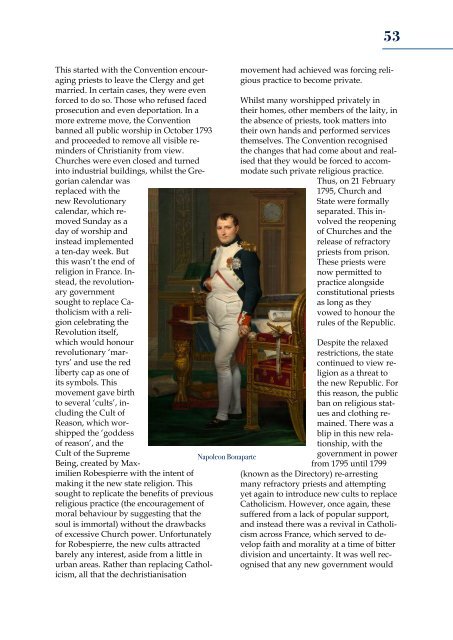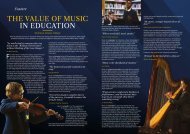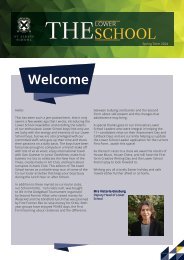You also want an ePaper? Increase the reach of your titles
YUMPU automatically turns print PDFs into web optimized ePapers that Google loves.
53<br />
This started with the Convention encouraging<br />
priests to leave the Clergy and get<br />
married. In certain cases, they were even<br />
forced to do so. Those who refused faced<br />
prosecution and even deportation. In a<br />
more extreme move, the Convention<br />
banned all public worship in October 1793<br />
and proceeded to remove all visible reminders<br />
of Christianity from view.<br />
Churches were even closed and turned<br />
into industrial buildings, whilst the Gregorian<br />
calendar was<br />
replaced with the<br />
new Revolutionary<br />
calendar, which removed<br />
Sunday as a<br />
day of worship and<br />
instead implemented<br />
a ten-day week. But<br />
this wasn’t the end of<br />
religion in France. Instead,<br />
the revolutionary<br />
government<br />
sought to replace Catholicism<br />
with a religion<br />
celebrating the<br />
Revolution itself,<br />
which would honour<br />
revolutionary ‘martyrs’<br />
and use the red<br />
liberty cap as one of<br />
its symbols. This<br />
movement gave birth<br />
to several ‘cults’, including<br />
the Cult of<br />
Reason, which worshipped<br />
the ‘goddess<br />
of reason’, and the<br />
Cult of the Supreme<br />
Being, created by Maximilien<br />
Robespierre with the intent of<br />
making it the new state religion. This<br />
sought to replicate the benefits of previous<br />
religious practice (the encouragement of<br />
moral behaviour by suggesting that the<br />
soul is immortal) without the drawbacks<br />
of excessive Church power. Unfortunately<br />
for Robespierre, the new cults attracted<br />
barely any interest, aside from a little in<br />
urban areas. Rather than replacing Catholicism,<br />
all that the dechristianisation<br />
movement had achieved was forcing religious<br />
practice to become private.<br />
Whilst many worshipped privately in<br />
their homes, other members of the laity, in<br />
the absence of priests, took matters into<br />
their own hands and performed services<br />
themselves. <strong>The</strong> Convention recognised<br />
the changes that had come about and realised<br />
that they would be forced to accommodate<br />
such private religious practice.<br />
Thus, on 21 February<br />
1795, Church and<br />
State were formally<br />
separated. This involved<br />
the reopening<br />
of Churches and the<br />
release of refractory<br />
priests from prison.<br />
<strong>The</strong>se priests were<br />
now permitted to<br />
practice alongside<br />
constitutional priests<br />
as long as they<br />
vowed to honour the<br />
rules of the Republic.<br />
Despite the relaxed<br />
restrictions, the state<br />
continued to view religion<br />
as a threat to<br />
the new Republic. For<br />
this reason, the public<br />
ban on religious statues<br />
and clothing remained.<br />
<strong>The</strong>re was a<br />
blip in this new relationship,<br />
with the<br />
Napoleon Bonaparte<br />
government in power<br />
from 1795 until 1799<br />
(known as the Directory) re-arresting<br />
many refractory priests and attempting<br />
yet again to introduce new cults to replace<br />
Catholicism. However, once again, these<br />
suffered from a lack of popular support,<br />
and instead there was a revival in Catholicism<br />
across France, which served to develop<br />
faith and morality at a time of bitter<br />
division and uncertainty. It was well recognised<br />
that any new government would


















